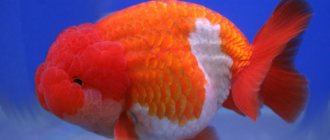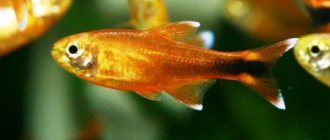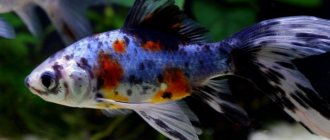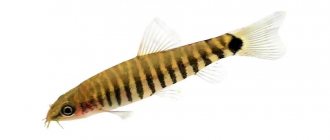Everything you wanted to know about Goldfish - Water Eyes. This is a variety of the well-known “goldfish”, a member of the carp family. This variety is artificially bred. It is also called shuigong or bubble eye.
The body of the fish is rounded - ovoid in shape, an adult reaches 18 cm in length. Water eyes are somewhat reminiscent of stargazers, only the eyes of this breed are much larger. They are convex, with bubbles filled with liquid located nearby. Shuigons' eyes begin to enlarge from about 4 months of age. The fins are paired, with the exception of the fin on the back, which is missing. The tail does not go down and is forked. The anal is also bifurcated. The back is low, the head gently blends into the dorsal profile. The coloring of water eyes varies, but silvery individuals with a reddish tint to the head are considered especially valuable.
Did you know that... (interesting things about water eyes):
- The first mention of goldfish in China dates back to 968-975.
- The water eye breed was bred in China as a result of crossing goldfish and silver Chinese crucian carp.
- Despite the fact that the thin-walled eye vesicles of this breed are extremely fragile, after damage they recover within a month.
- Using special food additives, you can improve the natural color of your fish.
Appearance and gender differences
The ovoid body of the water eyes is round, the back is low, the profile of the head smoothly blends into the profile of the back. The fins are all paired; there is no dorsal fin. The caudal fin does not hang down, it is forked. The anal is also bifurcated. Unlike stargazers, the eyes of water peepers are large and strongly convex, looking like bubbles filled with liquid hanging on both sides of the head. Are the eyes of the best specimens equal in size? bodies. Eyes begin to grow in young individuals, older than 3-4 months. The coloring is different. The most common colors are silver, orange and brown. The combination of a golden body and a red head is the most valuable. The length of water eyes is about 18 cm, often these aquarium fish lag behind other species and breeds in growth.
Interesting facts about water eyes:
- Water eyes are also called shuigong or bubble eyes, they were bred in China by crossing goldfish and goldfish;
- These fish came to Europe only in the middle of the last century;
- Bubble eyes have very sensitive eyes, they can even burst or droop, but recover over time;
- The most valuable fish are silver in color with a red tint to the head;
- The color of the fish stabilizes only after 2-3 years; before this, the fry have a faded or completely colorless color.
(Visited 91 times, 1 visits today)
Conditions of detention
Water eyes kept in an aquarium with a volume of at least 50 liters per fish, it is better if it is an aquarium of at least 100 liters, in which a couple of fish will be placed. By increasing the size of the aquarium, the population density can be increased slightly, so 3-4 fish can be placed in an aquarium with a volume of 150 liters, and 5-6 in a 200 liter aquarium, etc. But with increasing population density, attention should be paid to good water aeration. These aquarium fish love to dig into the soil, so it is better to use pebbles or coarse sand as it, then it will not be so easy for the fish to scatter it. The aquarium itself should be spacious and have a view, in which large-leaved aquarium plants should be placed. However, Water Eyes quickly spoil delicate plants, or the surface of the leaves becomes contaminated by settling particles of waste suspended in water on them. To avoid this, plant plants with a strong root system and hard leaves in the aquarium. Plants such as egg capsule, vallisneria, sagittaria, or elodea are very suitable, as they are the most hardy. Goldfish - Watereyes are kept in the same aquarium along with calm species of aquarium fish. The aquarium must have natural light and good filtration. All varieties of goldfish prefer good aeration. Fish are not particularly sensitive to the water parameters in the aquarium. Water hardness should be 8 - 25°, with an acidity of 6-8. It is advisable to change some of the water in the aquarium regularly. When it comes to food, Water Eyes are unpretentious; they eat a lot of everything. Their diet should contain both living and plant foods. Despite the gluttony of goldfish, you should not overfeed them. The amount of food they consume daily should be approximately 3% of the fish's weight. Adult fish should be fed twice a day - the first time early in the morning, and the second time in the evening. The amount of food is calculated for 10-20 minutes of feeding, then the remains of uneaten food are removed from the aquarium. Adult fish that receive proper nutrition can endure a long week-long fast without harm to their health.
Goldfish "Comet"
This variety was developed in the USA. Such fish are often kept in garden ponds together with or instead of the famous ornamental Koi carp. Outwardly, they resemble an ordinary goldfish, but their body has more elongated proportions. The Comet's tail can be almost equal to the length of its body (hence the name - due to its resemblance to a comet with a long trail).
Goldfish "Comet". MalchauDK
In addition, Comet goldfish also have noticeably longer fins than regular goldfish, and the tail fin has characteristic pointed tips.
These are very nimble “sports” fish that can move at high speed. The most common species are orange-red or bicolor (red and white). But such fish can also have pure white, chocolate and yellow colors.
Advantages of the Comet goldfish:
- increased endurance;
- Possibility of use in garden ponds.
Disadvantages of Comet goldfish:
- requires a large aquarium volume (at least 180 liters of water per adult);
- outwardly resembles an ordinary carp.
Breeding
When breeding water eyes , difficulties arise in selecting breeders: the eyes of the fish must be the same in shape and size, symmetrical, the back without bumps, and straight. When handling water eyes, especially when catching, special precautions are needed, since the eyes are the most vulnerable place of these fish. Damaged bubbles are restored quickly, but despite this, plants and objects with sharp edges should not be in the aquarium. All goldfish, regardless of variety, can spawn in an aquarium with a capacity of 20 - 30 liters. It is necessary to place sandy soil in it and plant small-leaved plants. For spawning, it is customary to place one female on two or three two-year-old males. Before spawning, they should be kept separately for 2-3 weeks. In the spawning aquarium, it is recommended to maintain the temperature at 24 - 26 ° C. To stimulate spawning, it is necessary to gradually heat the water until its temperature rises by 5-10 °C. At the same time, the males begin to quickly rush around and chase the females, who lose their eggs, scattering them around the entire perimeter of the aquarium, mainly they end up on plants. In total, the female lays about 10,000 eggs. As soon as the spawning is over, the producers must be removed from the aquarium. The initial food for the hatched fry will be “live dust”. They can also be given special food, which is now available in abundance on the market, intended for feeding goldfish fry, for example, Sera Mikron.
Liked? Share with your friends!
Social buttons for Joomla
Unusual fish
Every owner of an aquarium wants to fill it not only with standard fish, but also with aquatic inhabitants of unusual breeds, similar to fairy-tale creatures. This category includes fish that have exotic characteristic features: a non-standard body structure or bright colors. Such pets have an increased price and also require special feeding.
Decorative amazing aquarium inhabitants include:
- Aravana;
- Tetradon green;
- Tishrov perch;
- Lala Glass Perch;
- Glass Angel;
- Splash fish;
- Argus fish;
- Elephant fish;
- Swallow fish;
- Freshwater moray eel;
- Carapace;
- Imperial minnow.
Rasbora Brigitte
Rasbora Brigitta photo
Distribution: endemic to Borneo (Southeast Asia).
Water temperature: 25-28.
Limit size in an aquarium: up to 3 cm.
The recommended aquarium volume for a flock is from 50 liters.
Rasbora brigittae (Boraras brigittae) is a wonderful small fish that can be recommended to everyone, both professionals and beginners. It can only be kept with other small and harmless fish. You can also keep rasbor together with shrimp without any problems, to which they do not cause any harm.
Rasbora Brigitta photo
The body of the fish is decorated with a black and green stripe, which is bordered by bright red and bright orange lines. The stripe ends near the root of the tail with a black wedge-shaped dot. Males are brighter than females. Their body is colored red, the contrast of which becomes higher as they grow older. In females the color is more faded, pinkish or pale orange. The dominant male looks especially beautiful, his color glowing red. The remaining males are paler in color. Adult females are slightly larger than males and have a more rounded abdomen. Due to their brightness, Brigitta rasboras make an excellent decoration for any small aquarium.
In their natural habitat they live in water with few plants and light, but in an aquarium it is better to have plenty of plants and hiding places. Mosses, small-leaved plants, floating plants - all this will create a cozy and calm little world for Brigitte's rasbora.
Rasbora Brigitta photo
It is better to feed Brigitte slowly sinking food, because... Doesn't feed from the ground at all. Dry and frozen brine shrimp work well. Feeding aquarium fish should be correct: balanced, varied. This fundamental rule is the key to the successful keeping of any fish, be it guppies or astronotuses. The article “How and how much to feed aquarium fish” talks about this in detail; it outlines the basic principles of the diet and feeding regime of the fish.
In this article, we note the most important thing - feeding fish should not be monotonous; the diet should include both dry food and live food. In addition, you need to take into account the gastronomic preferences of a particular fish and, depending on this, include in its diet food either with the highest protein content or, conversely, with plant ingredients.
Popular and popular food for fish, of course, is dry food. For example, you can constantly and everywhere find food on aquarium shelves - the leader of the Russian market; in fact, the range of food for this Tetra is included as individual food for a specific type of fish: for goldfish, for cichlids, for loricariids, guppies, labyrinths, arowanas, discus, etc. .d. Tetra has also developed specialized foods, for example, to enhance color, fortified, or for feeding fry. You can find out detailed information about all Tetra feeds on the company's official website - here.
It should be noted that when purchasing any dry food, you should pay attention to the date of its manufacture and shelf life, try not to buy food in bulk, and also store food in a closed state - this will help avoid the development of pathogenic flora in it
Spine newt, also known as ribbed newt (Pleurodeles waltl)
Muddy ribbed newt photo
The conditions for keeping the spiny newt are not much different from the ordinary one, however, it is worth considering that Pleurodeles waltl is much larger (up to 23 centimeters), accordingly, it needs a larger aquarium. Females of this species are usually larger than males, but they have a shorter tail.
Mud ribbed newt photo
When keeping this species, it should be taken into account that they have pointed ends of the ribs on their sides, which, when in danger, secrete a poisonous, very burning substance. It can damage the skin, and in some people cause an allergic reaction, even fatal, so it is better not to touch the ribbed newt with your bare hands.
Diseases of newts in the aquarium
Newts, like fish, unfortunately, sometimes get sick.
They can be affected by both fungal (most often saprolegniosis and mucorosis), and parasitic and infectious diseases. A common and dangerous infectious disease of newts is the so-called “red leg”, in fact, it is sepsis, and it is called red leg because one of the symptoms is hemorrhages under the skin of the abdomen and upper parts of the legs, from which they acquire a color from pink to bright red color. Other symptoms may also include wounds on the skin; if the newt gets out of the water and dries out a little, then around the wounds you can see a black border, lethargy, even complete apathy, and refusal to eat. The disease requires immediate treatment: if a sick newt lives with relatives, it must be isolated in a quarantine container, since the disease is contagious. Next, it is best to find a veterinary laboratory where they can do tests to understand which pathogen is responsible for the occurrence of sepsis in a particular case, so as not to poison the newt with an antibiotic to which the microbes may be insensitive. If it is not possible to do an analysis, then there is no other way - the antibiotic will have to be selected empirically (experimentally): almost all antibiotics from the human first aid kit can be used in treatment, but most often tetracycline is used, at a dose of 50 mg/kg of animal weight through the mouth with food, aminoglycosides (amikacin, gentamicin) 20 mg/kg body weight or metronidazole (Trichopol) at a dose of 50-100 mg/kg for 5-7 days. There are also more complex methods - introducing a solution of chloraphenicol into the stomach of an amphibian through a probe. The dosage is as follows: the first administration of 8 mg of the drug in 2 ml of water, then for 6 days the administration of 4 mg of the drug in 1 ml of water, and then the prophylactic administration of a similar dose of chloraphenicol once a week for several weeks. It is possible to use medicinal baths, 15 ml of sulfadimidine solution per 10 liters of water. The duration of the bath is 1 hour, baths last for two weeks. In the event of an epidemic, complete disinfection and restart of the aquarium is necessary.
Common newt (Lissotriton vulgaris)
Common newt photo
The common newt belongs to the genus of small newts and is listed in the Red Book of Russia. Sizes from 7 to 11 centimeters, body color from olive to brown, abdomen yellowish or light orange. Sex differences are weak most of the time, males are slightly larger than females. Distinctive features become visible during the mating season - males develop a crest. The conditions for keeping it in the aquarium are as follows:
— Aquarium volume for a newt: from 15 liters, it is better, of course, more, especially if you plan to keep the newt not alone, but in a group of relatives or in the vicinity of fish. It is necessary to equip one or more islands, since newts are amphibious animals that come to land from time to time.
An ideal option would be a special Tetra ReptoAquaSet terrarium.
Aquarium for newts
And the bottomless range of REPTI-ZOO products in the attached catalog will help you in arranging your aquarium; you will find everything you need for newts: soils, islands, plants, heating pads, lamps, etc. (the catalog is huge, it takes 2-5 seconds to load, we recommend downloading it to your computer).
— Water temperature for newt. Newts are cold-water creatures. The required water temperature for keeping them is 18 - 22 degrees Celsius. And if you want to bring the newt’s living conditions as close as possible to natural ones, then to organize the wintering period, the water in the aquarium will have to be cooled to 5-8 degrees. Therefore, think about cooling the water in the aquarium in advance.
- Acidity. The pH range of newts is very wide; they live in both acidic (5.5) and almost alkaline water (7.8), but it must be remembered that, as with keeping fish, the unacceptable range of values is more important, but the stability of the indicator. Sudden changes in pH are tolerated very poorly by any living creature.
— Water hardness for newt. They prefer either soft or medium-hard water, dH range from 5 to 15.
— Lighting for newt. The issue of lighting for the newts themselves is not fundamental, but it is still required for the vegetation in the aquarium. When designing the lighting for the newts' future home, remember that the lamp must be positioned so that it does not heat the water!
Common newt photo
— Soil for newt. The issue of soil is extremely important. Remember: you need to choose a soil fraction such that individual particles cannot fit into the newt’s mouth. Otherwise, accidental consumption of soil is possible, which will most likely lead to intestinal obstruction and death of the pet.
— Plants for newt. It is preferable to use live plants, because this makes your aquarium more natural, both aesthetically and biologically, living plants play an important role in the functioning of the nitrogen cycle in the aquarium, and if you decide to breed newts, then you cannot do without living plants at all, the female spawns in them, then tucks up the leaves, providing protection for the offspring, and the young newts hide in dense thickets.
— Filtration. Here, the recommendations for keeping fish and newts in an aquarium are the same: the filter should pump 6-10 volumes of the aquarium per hour.
— Water changes. Different sources contain different recommendations for water changes, from 15 to 30% of water per week. We think that in this case it is correct to take the average value of 20% and focus on the individual characteristics of your aquarium.
From the editor: A simple, easy moss game. How do you like it?
A cover glass is required, otherwise the pet may escape from the aquarium into the “big world”.











